Recycled leather offers durability and a genuine leather feel by repurposing leather scraps, while vegan leather provides a cruelty-free, water-resistant alternative made from synthetic or plant-based materials. Choosing between recycled leather and vegan leather for bags depends on preferences for sustainability, texture, and environmental impact.
Table of Comparison
| Feature | Recycled Leather | Vegan Leather |
|---|---|---|
| Material Source | Reclaimed genuine leather scraps | Synthetic materials (PU, PVC) or plant-based (cork, pineapple) |
| Environmental Impact | Reduces leather waste, lower carbon footprint than new leather | Zero animal use, variable ecological footprint depending on material |
| Durability | High, retains leather's natural strength | Moderate to high, varies by material composition |
| Appearance | Authentic leather look and feel | Varies: can mimic leather realistically or have unique textures |
| Price | Mid to high range | Low to mid range |
| Water Resistance | Moderate, can be treated for better resistance | Generally water-resistant, especially synthetic types |
| Breathability | Good breathability | Poor breathability, may cause moisture buildup |
| Maintenance | Requires conditioning similar to natural leather | Easy to clean with mild soap and water |
| Eco-Friendly Credentials | Supports waste reduction and circular economy | Supports cruelty-free fashion; sustainability depends on material source |
Introduction to Recycled and Vegan Leather
Recycled leather is made by repurposing leather scraps and fibers, reducing waste while maintaining durability and a natural texture. Vegan leather, often crafted from synthetic materials like polyurethane or plant-based alternatives, offers an animal-free option with diverse design possibilities and water resistance. Both materials provide sustainable and cruelty-free choices for eco-conscious bag consumers seeking style and environmental responsibility.
What is Recycled Leather?
Recycled leather is a sustainable material made by repurposing leftover leather scraps from manufacturing processes and bonding them together with natural or synthetic binders, often combined with fabric backing for added durability. This eco-friendly alternative retains the authentic texture and breathability of genuine leather while reducing waste and the environmental impact associated with traditional leather production. Compared to vegan leather, which is typically made from synthetic or plant-based materials, recycled leather offers a more tactile and natural leather experience with a lower carbon footprint than virgin leather.
What is Vegan Leather?
Vegan leather is a synthetic material designed to mimic the look and feel of genuine leather without using animal hides, often made from polyurethane (PU) or polyvinyl chloride (PVC). It is valued for being cruelty-free, environmentally friendly when derived from sustainable sources, and typically easier to maintain compared to traditional leather. Vegan leather for bags offers a durable and stylish alternative, appealing to consumers seeking ethical fashion choices.
Environmental Impact Comparison
Recycled leather reduces waste by repurposing existing leather scraps, lowering landfill contributions and minimizing the need for new animal hides. Vegan leather, often made from synthetic materials like polyurethane or plant-based alternatives such as pineapple leaves or cork, offers a cruelty-free option but can have varied environmental impacts depending on production processes and material sourcing. While recycled leather reduces resource consumption and pollution compared to traditional leather, eco-friendly vegan leather made from sustainable materials generally has a lower carbon footprint and avoids chemical tanning processes.
Durability and Longevity
Recycled leather offers enhanced durability due to its natural leather fibers combined with sustainability benefits, making it resistant to wear and tear over time. Vegan leather, typically made from polyurethane or plant-based materials, varies widely in durability but often lacks the long-term toughness of recycled leather. Choosing recycled leather for bags ensures extended longevity and robust use, while vegan leather prioritizes animal-free materials but may require more careful handling to maintain appearance.
Aesthetics and Design Flexibility
Recycled leather offers a natural grain and texture that closely resembles genuine leather, providing a classic and luxurious aesthetic ideal for sophisticated bag designs. Vegan leather, often made from polyurethane or plant-based materials, allows for a broader range of colors, patterns, and finishes, enabling designers to experiment with bold, modern, and customizable styles. The enhanced design flexibility of vegan leather makes it popular for fashion-forward bags, while recycled leather appeals to customers seeking eco-friendly options without sacrificing a traditional look.
Cost and Market Trends
Recycled leather offers a cost-effective alternative to traditional leather, typically priced lower due to its use of upcycled materials, appealing to eco-conscious consumers seeking durability and authenticity. Vegan leather presents a wider price range, often influenced by the choice of synthetic or plant-based materials, with rising demand driven by sustainability trends and increasing innovation in eco-friendly production methods. Market analysis indicates growing consumer preference for vegan leather bags, spurred by ethical considerations and expanding availability, while recycled leather maintains steady niche appeal among environmentally mindful buyers.
Ethical and Animal Welfare Considerations
Recycled leather bags minimize environmental impact by repurposing existing leather waste, reducing the demand for new animal hides and preserving animal welfare. Vegan leather, crafted from synthetic or plant-based materials, eliminates animal exploitation entirely, offering a cruelty-free alternative. Both options promote ethical consumer choices by addressing sustainability and animal rights, but recycled leather still involves animal-derived materials, while vegan leather supports a fully animal-free production process.
Maintenance and Care
Recycled leather requires regular conditioning to prevent cracking and maintain its softness, while avoiding prolonged exposure to moisture and direct sunlight to extend its lifespan. Vegan leather typically demands less intensive maintenance, needing only occasional cleaning with a damp cloth and protection from extreme heat to prevent peeling. Both materials benefit from proper storage in a cool, dry place to preserve their appearance and durability over time.
Which Leather is Better for Bags?
Recycled leather offers enhanced durability and a more authentic leather feel, making it ideal for high-quality, long-lasting bags. Vegan leather, typically made from polyurethane or plant-based materials, provides a cruelty-free and lightweight alternative but may lack the same breathability and strength. For bags demanding both sustainability and premium texture, recycled leather is generally considered the better option.

Infographic: Recycled leather vs Vegan leather for Bag
 azmater.com
azmater.com